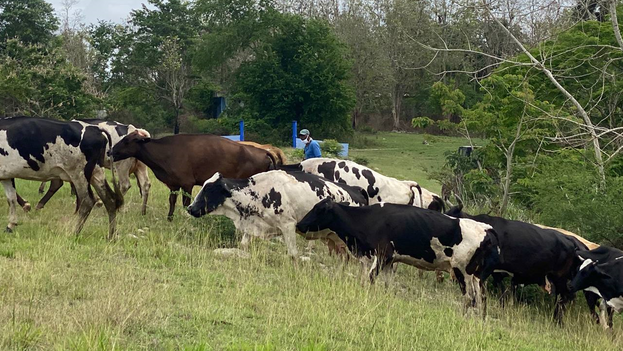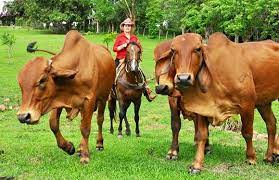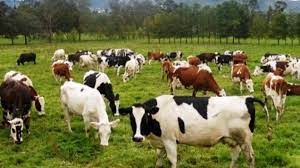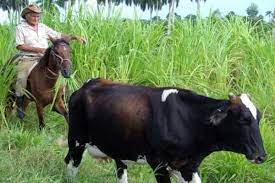CUBA POR DENTRO: SE ACELERA EL DESPLOME DE LA GANADERIA EN CUBA Y EL ACCESO A LA CARNE
Se acelera el desplome de la ganadería y también el acceso a la carne en Cuba. La tasa de vacuno per cápita ha pasado de las 0,78 cabezas en 1959 a las 0,3 en 2021. En 1959, la cabeza de ganado era de 5,1 millones para los 6,5 millones de habitantes de la Isla en ese momento.
Con la población actual de la Isla, de 11,3 millones de habitantes oficialmente, la tasa per cápita apenas alcanza 0,3 cabezas de ganado.
EL DESPLOME DE LA GANADERIA VACUNA parece no tener fin. Desde 1985 se ha perdido la cuarta parte del rebaño y desde 2014 hasta este septiembre se ha reducido un 10,2%, según advierte el economista Pedro Monreal con datos oficiales publicados por la Oficina Nacional de Estadística de Cuba. (ONEI).
En el año 1985 había poco más de cinco millones de cabezas de ganado en Cuba, frente a los actuales 3,7 millones. El breve período que va de 2006 a 2014 es el único en que la masa ganadera tuvo respiro y se recuperó ligeramente, pasando de los 3,703 millones a los 4,1. A partir de ese momento, la caída se mantiene constante de nuevo.
Los datos contrastan más aún si se retrocede en el tiempo. En el año 1959, las cabezas de bovino eran 5,1 millones para los 6,5 millones de habitantes de la Isla en aquel momento. A partir de esa fecha, la masa de ganado vacuno empieza una notable subida que alcanza su punto máximo en 1967, cuando se llega a los 7,1 millones. Aunque la población entonces ya ha aumentado a 8,4 millones de cubanos, la relación pasa de 0,78 cabezas por persona a 0,84. Pero a partir de entonces, y salvo una fugaz recuperación en el año 76, la caída es sostenida y desde 1986 nunca ha vuelto a alcanzar los cinco millones de cabezas.
Con la población actual de la Isla, de 11,3 millones de habitantes oficialmente, la tasa per cápita apenas alcanza 0,3 cabezas de ganado.
Los datos, todos ellos oficiales, ponen negro sobre blanco lo que los cubanos pueden ver en las tarimas de los mercados. La carne de res es un bien de lujo inalcanzable que, primero fue sustituido por el cerdo y ahora, convertido este también en una quimera, por el pollo, en la mayoría de las ocasiones congelado e importado.
Las 63 medidas puestas en marcha en abril de este año para estimular la producción de alimentos incluían una novedad muy celebrada, la liberalización del sacrificio, consumo y venta de carne de res, además de la leche. Los ganaderos que tuvieran una producción mayor a la contratada por el Estado podrían conseguir un permiso para vender de forma privada el excedente. Aún es pronto para evaluar los resultados que, con el tiempo podría tener el paquete normativo, pero por ahora las señales no son muy prometedoras.
INSIDE CUBA: THE CRASH OF LIVESTOCK IN CUBA AND THE ACCESS TO THE MEAT
The collapse of livestock is accelerated and also access to meat in Cuba. The per capita cattle rate has gone from 0.78 head in 1959 to 0.3 in 2021. In 1959, the head of cattle was 5.1 million for the 6.5 million inhabitants of the Island in that country. moment. With the island’s current population of 11.3 million officially, the per capita rate barely reaches 0.3 head of cattle.
THE CRASH OF THE VACCINE LIVESTOCK SEEMS TO NEVER END. Since 1985, a quarter of the herd has been lost and from 2014 to this September it has been reduced by 10.2%, according to the economist Pedro Monreal with official data published by the National Statistics Office of Cuba. (ONEI).
In 1985 there was just over five million head of cattle in Cuba, compared to the current 3.7 million. The short period that goes from 2006 to 2014 is the only one in which the livestock population had respite and recovered slightly, going from 3.703 million to 4.1. From that moment on, the drop remains constant again.
The data is even more contrasting if you go back in time. In 1959, the head of cattle was 5.1 million for the 6.5 million inhabitants of the Island at that time. As of that date, the mass of cattle begins a remarkable rise that reaches its maximum point in 1967, when it reaches 7.1 million. Although the population by then has already increased to 8.4 million Cubans, the ratio goes from 0.78 heads per person to 0.84. But from then on, and except for a fleeting recovery in 76, the fall is sustained and since 1986 it has never again reached five million head.
With the island’s current population of 11.3 million officially, the per capita rate barely reaches 0.3 head of cattle.
The data, all of the official, but black on white what Cubans can see on the market platforms. Beef is an unattainable luxury good that was first replaced by pork and now, this also turned into a chimera, by chicken, most of the time frozen and imported.
The 63 measures launched in April this year to stimulate food production included a much-celebrated novelty, the liberalization of the slaughter, consumption, and sale of beef, in addition to milk. Ranchers who had a production greater than that contracted by the State could obtain a permit to sell the surplus privately. It is still too early to evaluate the results that, over time, the regulatory package could have, but for now the signs are not very promising.
Agencies/ 14yMedio/ Extractos/ Excerpts/ Internet Photos/ Arnoldo Varona/ www.TheCubanHistory.com
THE CUBAN HISTORY, HOLLYWOOD.



 CUBA POR DENTRO: Se Acelera el Desplome de la Ganaderia en Cuba y el Acceso a la Carne. * INSIDE CUBA: The Crash of Livestock in Cuba and the Access to the Meat. PHOTOS
CUBA POR DENTRO: Se Acelera el Desplome de la Ganaderia en Cuba y el Acceso a la Carne. * INSIDE CUBA: The Crash of Livestock in Cuba and the Access to the Meat. PHOTOS





